Whenever we hear the name frog, we automatically think of a green, little jumpy creature near a marsh. So, habitually, it’s not wrong to assume they’d be good at swimming. But, frogs don’t just consist of one species, there are hundreds! And so arises the question- can all of them swim?
One particular kind- the tree frogs, like most other fellows, can swim. But here’s the catch, they’re not as good as the others. And it’s because they have terrestrial lives, for the most part.
The adult tree frog is well adapted to its arboreal lifestyle. They can cling to branches thanks to their lightweight bodies and big, rounded toe pads. But these characteristics are not great for swimming, which is why tree frogs cannot swim very efficiently unlike pond frogs, which have characteristics that are well suited for swimming.
Down below, I’ll discuss everything you ought to know about tree frogs and their aptitude for swimming. Be sure to stay with me…
How do tree frogs swim?
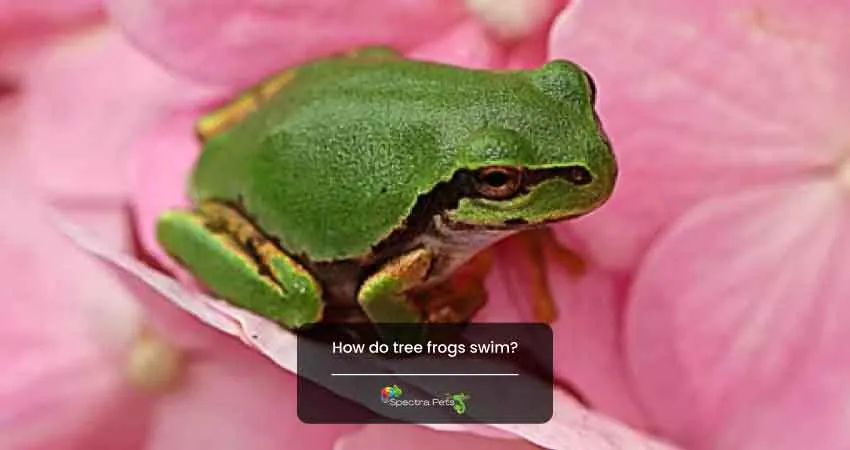
If you’ve ever wondered about how tree frogs swim, you’re in luck because this article is the right place to answer that query. Unlike their aquatic relatives, these amphibians have a different approach to swimming. But they do have something in common- tree frogs require water to reproduce and survive, just like pond frogs do.

Tree frogs are skilled swimmers as tadpoles and have developed gills for breathing. As they get older, they no longer possess the ability to swim, and they spend their entire adult lives on land and in trees.
In contrast to aquatic frogs, tree frogs can swim due to their physical makeup. Frogs that are aquatic live and eat in ponds or lakes, and they must frequently submerge themselves in water to maintain hydration. It’s unclear why, but it might have something to do with their capacity to breathe underwater.
Tree frogs rely on soil moisture and tree moisture to survive. It’s also known as a “tree frog,” and it’s uncommon to find it in a pond.
Can tree frogs breathe while submerged?
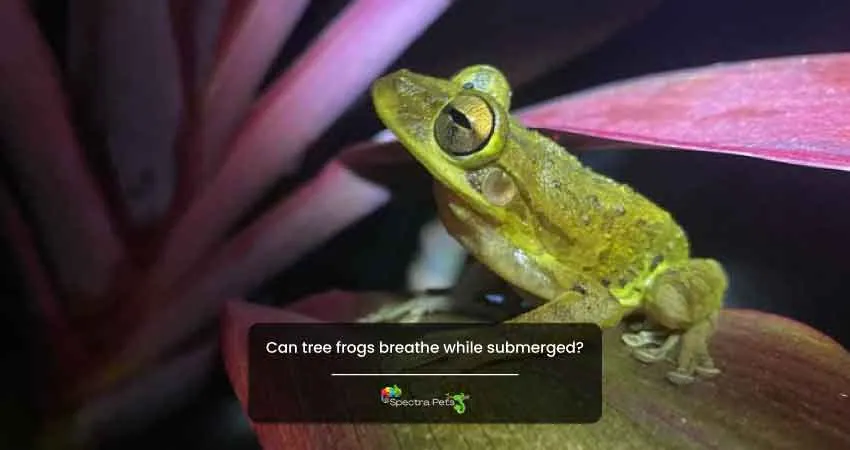
Tadpoles of tree frogs have gills that allow them to breathe underwater. Their gills are made up of a thin membrane and a mesh of arteries. Through these membranes, the bloodstream receives oxygen. The membranes allow the bloodstream’s carbon dioxide to exit and enter the water at the same time. It is thanks to this gaseous substance that tadpoles can breathe underwater just like fish.
The tadpoles’ gills are lost when they become froglets. Instead, they learn to breathe by using their skin, thin mouth and throat membranes, and their lungs. This process is known as cutaneous respiration.
Frogs must hold their breath and exclusively breathe through their skin while submerged because they are unable to use their lungs to do so. When they come into contact with water that contains dissolved oxygen, the oxygen diffuses into the bloodstream, and the bloodstream releases carbon dioxide into the water.
In order to breathe air, frogs must surface after a short period of time submerged. This is because this type of breathing typically does not provide them with all the oxygen they require.
How Long Can Tree Frogs Stay Underwater?
The amount of oxygen tree frogs can absorb from the water through their skin and how long they can hold their breath determines how long they can stay underwater. This can usually be determined by the following factors:
- Species
- Water Temperature
- Dissolved Oxygen content of Water
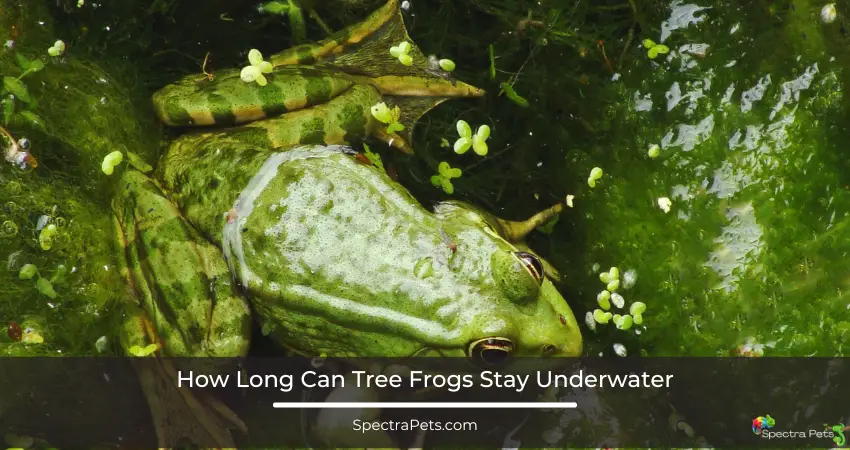
Species
Different species of tree frogs have different swimming abilities. The species of a particular tree frog is also important in determining how long it can stay underwater. While some tree frogs can only survive underwater for a brief period of time, others can withstand this for much longer.
Water Temperature
Since frogs are ectothermic (cold-blooded) creatures, the temperature of their surroundings will have an impact on how quickly they burn calories. They will require more oxygen because of their higher metabolic rate at higher temperatures. The opposite is accurate at lower temperatures. Frogs will require less oxygen because of their lower metabolic rate.
The water’s oxygen content will also be impacted by temperature. In comparison to warmer temperatures, colder temperatures cause more oxygen to dissolve into the water. This means that tree frogs can stay submerged for a lot longer at colder temperatures than they can at warmer ones.
Read More: Tree Frog Habitat Setup Guide
Dissolved Oxygen Content of Water
In comparison to still water, moving water has more oxygen. This occurs as a result of easier water dissolution of atmospheric oxygen. Water that is extremely stagnant only has oxygen dissolved on its surface. Anything below this top layer of water has a lower amount of oxygen.
The amount of dissolved oxygen in water is also influenced by aquatic plants and algae. Through photosynthesis, they generate oxygen during the day.
Aquatic plants will release carbon dioxide into the water at night after using up the dissolved oxygen through aerobic respiration. Due to these factors, the dissolved oxygen levels in water with a lot of aquatic vegetation that photosynthesizes will be at their highest in the afternoon when photosynthesis rates reach their highest and reach their lowest just before sunrise the following morning.
Frogs have an easier time breathing and staying underwater for longer periods in water with higher oxygen content.
Differences between Pond Frogs and Tree Frogs
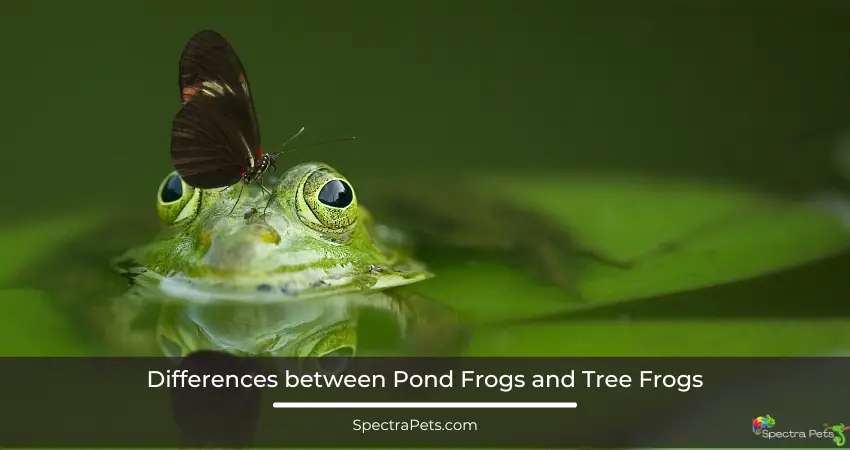
Compared to pond frogs, tree frogs have a very different body type. Tree frogs swim more slowly and are less adept at maintaining direction than pond frogs. These qualities might deter the frogs from taking a bath. Every frog species must, however, lay their eggs in an aquatic setting because these settings are necessary for the tadpoles’ development.
Can tree frogs drown?
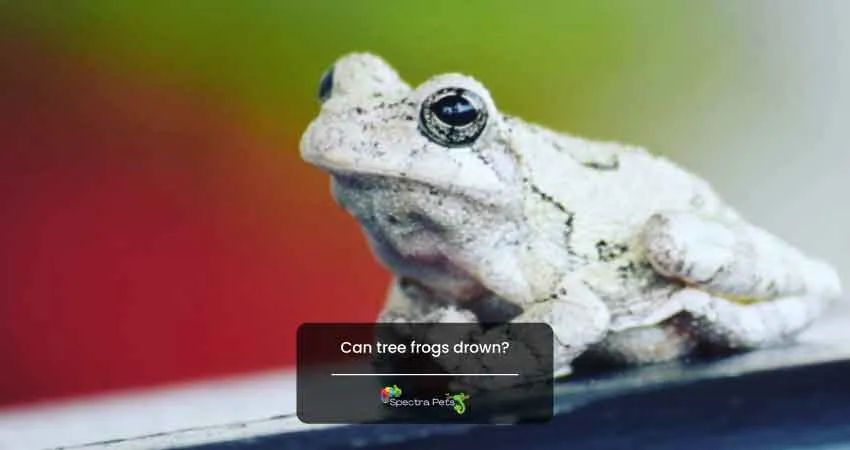
Tree frogs can drown even though they can breathe through the skin while submerged. Keep in mind that adult frogs use their lungs to breathe, and if those lungs fill up with water, they risk drowning. They can only stay submerged for a finite amount of time before they must surface to breathe air with their lungs because the oxygen absorbed through their skin is typically insufficient to fulfill all oxygen needs.
This was a surprise to me because I never thought that an amphibian could drown.
Frequently Asked Questions (FAQ)
1. Do tree frogs go in ponds?
Many tree frogs will move to ponds and other bodies of water during the breeding season to breed and lay their eggs.
2. Are tree frogs good swimmers?
3. Can green tree frogs swim?
4. Can gray tree frogs swim?
5. Can red-eyed tree frogs swim?
Wrapping Up
Despite possessing the physical skills needed to swim, tree frogs’ bodies are not designed for the activity. Tree frogs do not enjoy the water because they do not spend most of their lives in it.
Although adult tree frogs can swim, their anatomy is more suited to their arboreal lifestyle than swimming.
Similar Articles:
